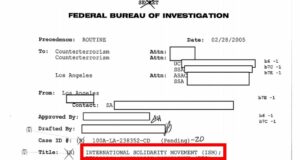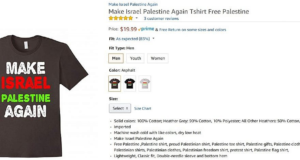October 21st, 2007
Despite OneVoice’s recent efforts to minimize the attention on its “10 Pillars,” especially in the wake of widespread grassroots criticism, the fact remains that OneVoice created these 10 pillars to present as a basis for negotiations, under the guise that they represent the will of the majority of Palestinians and Israelis.
As of October 20, 2007, OneVoice claimed 275,175 Palestinian signatories to “OneVoice Mandate” (where age requirement is only 15). According to OneVoice’s One Million Voices website, 58,000 have been polled as to whether they agree to these pillars. We could not find mention of any efforts to conduct this poll outside of the Occupied Palestinian Territory, so our understanding is that the vast majority of respondents reside in that area. OneVoice is only providing snippets of the results; information on their site indicates that approval rates for each of the pillars ranged from 23% to 85%. Since the sample is not statistically representative, it must be clarified that any findings are not representative of Palestinian opinion, and OneVoice’s use of terminology such as “consensus” is misleading.
Listed below are OneVoice’s 10 Pillars and a brief explanation of why each is problematic.
1. Two states: Do you agree that there will be two viable states: Israel will be the state of the Jewish people and Palestine the state of the Palestinian people, each recognizing the other as such, both democratic and respecting human rights, including minority rights?
Only people who have signed OneVoice’s mandate and affirmed their support for a two-state solution are eligible to participate in this exercise. Hence, the result for this pillar, in particular, is artificially high and not representative of Palestinian opinion on this issue.
The designation of Israel as “the state of the Jewish people” reaffirms and legitimizes Israel’s existence as a state built on racist foundations and reinforces the current racist trend that considers non-Jewish residents and citizens a demographic threat. By definition, a “state of the Jewish people” directly implies that non-Jews would continue to be disadvantaged and vulnerable. It also signifies that the Palestinian refugees would not be allowed to return to their homes in Israel, as that would threaten the Jewish character of the state.
Without defining its parameters, the Palestinian “state” that would emerge would not be territorially contiguous, nor would it have full sovereignty over its land and natural resources, thus rendering it not viable. Further, the creation of a Palestinian “state” cannot replace the inalienable right of the refugees to return to their homes and be compensated for their displacement.
2. Borders: Do you agree that the 1967 borders are the basis for an agreement, while border modifications will be used to accommodate the territorial and security needs of both sides?
By justifying modifications of the 1967 borders, OneVoice not only disregards international law, but also legitimizes Israel’s de-facto borders created by illegal settlements and the Segregation Wall, including its annexation of large settlement blocs around Jerusalem.
The word “while” suggests that modifications accommodating “territorial and security needs” do not have to be mutually agreed upon. This pillar legitimizes Israel’s goal of annexing the Jordan Valley, constituting approximately 25% of the West Bank, under the pretext of “security”. As for Palestinian security, it is directly violated by the presence of settlement blocs suggested by the next pillar; a clear indication that “territorial and security needs” addresses only Israel’s needs.
Furthermore, members of the Israeli government have already declared intentions to rid Israel of its indigenous Palestinian population and exchange Palestinian population centers for the coveted settlement blocs.
3. Settlements: Do you agree that settlements will be evacuated and that land exchanges along the border will permit inclusion of a limited number of settlement blocks?
As affirmed by numerous UN Security Council resolutions, all Israeli settlements in the West Bank, including East Jerusalem, are in violation of international law and present a major impediment to peace. Israel “proper” already encompasses 78% of historic Palestine; legitimizing its land grabs in the remaining 22% is not unacceptable.
The maintenance of these settlement blocs carves up the West Bank into isolated cantons. Some Palestinian towns, such as Qalqilya, are already cut off from other Palestinian population centers and strangled economically precisely due to the presence of settlements and their protective Segregation Wall.
Furthermore, these settlement blocs have been strategically built above important water aquifers, and Israel’s possession of these aquifers violates Palestinian rights to their own water, causing severe water shortages for the Palestinian population.
Finally, the wording of the pillar must be noted, and is reflective of OneVoice’s manipulative approach. A response of “I agree” signifies acceptance that Israel keeps its settlement blocs on occupied Palestinian land. An answer of “I don’t agree” would presumably signify that the respondent opposes the removal of settlements, be they individual settlements or settlement blocs. The choices preclude complete settlement removal, which is the only legitimate choice under international law, and the only choice acceptable to most Palestinians (82%, according to Jerusalem Media & Communication Center’s poll).
4. End of occupation and terror: Do you agree that Israel shall completely end the occupation, within the context of a comprehensive peace agreement and a cessation of all terror and violence on both sides, at which time all political prisoners will also be released?
Hinging an end of the occupation and release of political prisoners on “the context of a comprehensive peace agreement and a cessation of all terror and violence” indicates that the Palestinians must first end all resistance before Israel complies with international law. This is in tune with the failed Road Map, as it shifts the burden to the Palestinian Authority, requiring it to eliminate any Palestinian resistance before Israel becomes obliged to end its illegal occupation.
It is also unclear whether OneVoice considers Israel’s oppression of the Palestinian people as “terror and violence”, including indiscriminate shelling of population centers, raids into Palestinian towns and villages, extra-judicial killings, the use of “human shields” and other war crimes.
5. Security: Do you agree that the Palestinian state shall be demilitarized for an agreed upon period, but will posses a strong security force, and each state shall ensure that its territory is not used to threaten the security of the other?
This pillar reflects the imbalance prevalent in OneVoice’s approach. Why must the weaker party be demilitarized, while the stronger party maintains, without any limitations, the world’s fourth strongest military, and possesses nuclear weaponry?
Further, it is clear that, in synch with U.S. and Israeli plans, the purpose of the Palestinian security forces is to defend Israel from any Palestinian resistance, rather than providing security for its own citizens.
6. Jerusalem: Do you agree that Arab East Jerusalem will be under Palestinian sovereignty while the Jewish areas will be under Israeli sovereignty, and that each State shall have the right to establish its capital within its sovereign territory, recognized by the other and internationally?
This pillar suggests that not all of East Jerusalem would be part of the Palestinian state, but only the Arab-inhabited areas, while “the Jewish areas” (all of them) would remain under Israeli possession. These would obviously include the illegal settlements of Pizgat Ze’ev and Ma’ali Adumim, as well as other areas surrounding East Jerusalem that have been constructed there for the very purpose of annexing additional land east of the city.
A division under a system of demographics in a city which has been investing significant efforts in changing the demographic balance and “Judaizing” the area will create small pockets of a Palestinian ‘state’ inside the Jerusalem municipality, without access to social services that Palestinian residents are being taxed for, nor easy access to the rest of the West Bank.
7. Holy Sites: Do you agree that both States will guarantee security, access and freedom of worship to all significant religious sites giving due regard to the established customs of each religion?
The Segregation Wall currently obstructs such access to Palestinian Muslims and Christians. Such access is not practical without dismantling the Wall, in accordance with the 2004 Advisory Opinion of the International Court of Justice. Yet, there is no stipulation for such removal anywhere in OneVoice’s literature.
8. Refugees: Do you agree that the refugee problem must be resolved in a humane, fair, just and practical manner in the final Status Agreement?
This is vague and suggests that “a” solution should be reached, not necessarily based on international law or in accordance with human rights. Pillar 1, calling for Israel to be recognized as “the state of the Jewish people” signifies, in no uncertain terms, that the refugees would not be allowed back to their homes in what is now Israel. Such a concession of the refugees’ right to return, an inalienable human right as per international law, is simply unacceptable and should not be subject to negotiation.
9. Education and reconciliation: Do you agree that, in order to build reciprocal understanding, education against incitement, terror, hatred, fear and racism should be an integral and enforceable element of the permanent agreement; that Palestine and Israel shall foster economic, social and cultural cooperation in order to improve the lives of their citizens; and that physical barriers should not serve as an obstacle for this?
This is reasonable if it is applied equally, and can be easily implemented once the occupation is ended, i.e. “within the context of a comprehensive peace agreement” – a qualifier that was used only for imposing requirements on Palestinians before Israel ends the occupation. In fact, the Palestinian curriculum has been modified to facilitate reconciliation; the Israeli curriculum, however, continues to provide a racist narrative that denies Israel’s crimes against the Palestinian people.
Physical barriers, such as the Segregation Wall, will always be an obstacle to any kind of cooperative initiative. Economic, social, and cultural cooperation is not practical when people are separated by an 8 meter tall cement wall, or when one party is annexing and colonizing the land of another.
10. End of Conflict: Do you agree that a permanent peace agreement shall constitute the end of the conflict and must be implemented and democratically approved, and that then both governments will irrevocably renounce any further claims?
A permanent peace agreement would naturally constitute an ‘end to the conflict’ as long as the causes of the conflict are appropriately resolved.
Israel’s occupation of the West Bank and Gaza Strip, and the policies employed therein are the root cause of the “conflict”. Any ‘peace’ agreement that allows Israel to keep settlements inside the West Bank, that does not deal justly with the rights of Palestinian refugees, and that does not create a viable and sovereign Palestinian state, could not end the conflict between the Palestinians and Israel.
This pillar seeks to absolve Israel of its responsibilities and its compliance with international law, by rendering further Palestinian claims null and void upon reaching agreement with the Palestinian Authority, along parameters that are clearly in violation of international law and human rights.
It is not clear what constitutes a “democratically approved” agreement; all indications suggest that Palestinian refugees and diaspora would not be included in such a process, and that their rights are severely threatened.
It is important to also note that OneVoice fails to mention not only Israel’s Segregation Wall but also a number of other serious issues including the dotting of the West Bank with checkpoints, war crimes that Israel continues to commit on an almost daily basis, and the gradual ethnic cleansing of the Bedouins.
It is also disconcerting to notice OneVoice’s frequent use of the word “conflict” and rare use of the word “occupation.” To describe the situation as a “conflict” is problematic as it ignores the fact that this “conflict” is due to an illegal occupation. Furthermore, it suggests that the “conflict” is between two equal parties, ignoring the fact that one is a strong and aggressive occupier that is acting in violation of international law, while the other is a weak and mostly unarmed captive population.
OneVoice’s vision of a “two-state solution” does not include dismantling the Wall, removing the settlement blocs, or creating a viable, contiguous, and sovereign Palestinian state.
Were OneVoice truly interested in lobbying for a genuine peace agreement, it would base its pillars on the implementation of international law and the respect and affirmation of human rights. By advocating for negotiations outside of those parameters, OneVoice simply aids Israel in pressuring the weaker Palestinian side into permanently accepting conditions that cannot lead to a just or sustainable peace agreement.
 International Solidarity Movement Nonviolence. Justice. Freedom.
International Solidarity Movement Nonviolence. Justice. Freedom.


